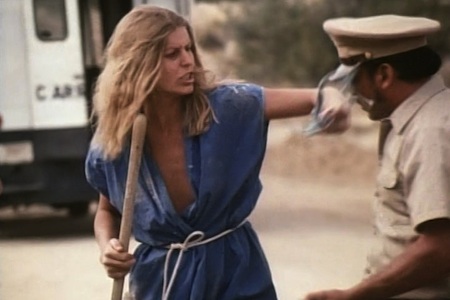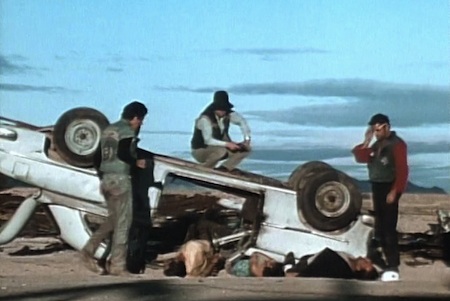Much ado has been made of late about Frankenfood. But there has been little attention paid to a much more benign if perhaps equally bizarre phenomenon we might call Frankenfilms. These are movies—excluding documentaries and experimental work—sewn together from a mad-scientist mixture of new and stock footage, often incorporating material from abandoned features, under-the-radar foreign ones, public domain flicks and whatnot. The trick is to combine these not-meant-to-be-together elements into something that at least faintly approaches artificial coherence, whether via connecting voice-over narration or editing wizardry. The trap is that this most inorganic way of assembling a feature so rarely manages to do so.
As a result, nearly all the (relatively) famous Frankenfilms are famously bad, nuts, “golden turkey”-type camp classics. Probably the best-known amongst fans of such things is 1969’s They Saved Hitler’s Brain, a senseless—yes, even more so than the title—assembly of footage clearly shot years apart, the more professional-looking being from a forgotten 1963 feature called The Madmen of Manoras. Another gem is 1985’s Night Train to Terror, which slapped together footage from three unreleased and/or uncompleted horror features, connecting them via new footage of “God” and “Satan” playing chess for the souls of some Flashdancing youth. No less than five directors had a hand in that one, and it’s quite possible none of them ever met another.
But the undisputed king of Frankenfilm is a longtime favorite amongst bad-movie aficionados. Not all Al Adamson‘s movies were created by severing limbs from different films (including his own) and scotch-taping them to the skeleton of a new, barely-there story. But even his entirely original features had a certain garage-sale ingenuity—and sometimes desperation—that left no doubt they came from a world where no extra dollar could be found or spared to patch a budgetary hole.
Such filmmaking needed to be resourceful onscreen and off, to frequently odd effect. Thus a 1970 biker flick named Hell’s Bloody Devils might abruptly stop its bloody action so the nicest characters can complement Colonel Sanders himself on “the best chicken [we’ve] ever eaten.” Why? Because in exchange for the plug, KFC agreed to feed the cast and crew for the whole shoot. Once production wrapped, at least thirty or so people probably never wanted to eat a drumstick again.
Designed primarily for the drive-in market, which was at its peak when they started and dying out (killed by cable/VHS) by the end, the films Adamson made with his producer partner Sam Sherman are shelter mutts—mangy, a tad pathetic, the opposite of purebred, but adoptably lovable if you’re not too picky about what you let in your home.
Their oeuvre contains some of the most notoriously tasteless (Satan’s Sadists) and hilariously bad (Dracula vs. Frankenstein) titles from a sixties-seventies “golden age” for exploitation movies. They knew they weren’t making art. (They couldn’t afford the luxury.) But they did make some jaw-dropping entertainment, whether its attractions were primarily intentional or not.
An actual Hollywood native, Adamson grew up on the outskirts of the industry—his dad was a minor cowboy star in “Poverty Row” westerns. When Al decided to make features himself, he got off to a start that was at once stumbling, useful, and typical: 1965’s Psycho-a-Go-Go was a crime drama unseen until seven years later, when some of its footage was used to pad out the sci-fi horror hot mess of his latest project, Blood of Ghastly Horror.
By the time that one rolled around, Al, Sam and their Independent-International Pictures company had cranked out eight or so features that duly made it into wide release. Their formula was simple: Keep costs low, low, low; hire washed-up older Hollywood stars for marquee value (often in glorified-cameo roles), and no-name younguns for everything else; recycle older footage when possible; and keep re-releasing the resulting product under different titles, on the assumption that drive-in and late-night-TV audiences will rarely or barely notice.
‘I would say I’ve never truly made a film that I liked,” Al Adamson lamented in more recent years.
When biker movies were all the rage after The Wild Angels and Easy Rider, Adamson & co. climbed upon their hogs and followed suit. Their two crowning achievements in that genre were both made in 1969, starred Russ Tamblyn (who just a few years earlier had been kicking up heels in the Oscar-winning West Side Story), and were shot partly on the Spahn Ranch that would become infamous that year for housing the Manson Family. (A fact Independent-International was not shy about using in their publicity.)
The Female Bunch, about a posse of man-hating, man-riding, man-branding she-devils, was brutal enough. But in the gratuitous-violence sweepstakes there was no topping Satan’s Sadists. It was advertised as “Hippie psychos on a mad murder spree!”—a fairly polite description given the catalog of horrors contained therein. Sherman later said its “particularly nasty” content had been the duo’s semi-jokey response to frustration at having several more respectable, up-market projects fail to get financing. (“I would say I’ve never truly made a film that I liked,” he lamented in more recent years.)
‘Dracula vs. Frankenstein’ defined ‘so bad it’s good’ for many people long before ‘Mystery Science Theater 3000’ and other professional snarksters drew first breath.
Interspersed between their several biker movies were others in another marketable genre, horror. Utilizing such aging creature-feature stars as John Carradine and Lon Chaney, Jr. (along with Adamson’s buxom blonde actress wife, Regina Carrol, whom Sadists introduced as “The Freak-Out Girl”), these films are infamously campy, shoddy, and random. 1970’s Horror of the Blood Monsters was an incredible whatsit that crammed together color-tinted B&W footage from a 1965 Filipino caveman adventure with new scenes on a spaceship. (Even more incredibly, within two years cinematographer Vilmos Zsigmond would graduate to prestige projects like Deliverance and McCabe & Mrs. Miller, later working with Spielberg, De Palma and Woody Allen.)
But even that tacky spectacle can’t compete with Dracula vs. Frankenstein, which defined “so bad it’s good” for many people long before Mystery Science Theater 3000 and other professional snarksters drew first breath. Lifting its music and some props from old Universal Studios horror classics, employing one star confined to a wheelchair (Carradine) and two more who were literally dying at the time (Chaney, J. Carrol Naish), it further throws hippies, a Vegas lounge act, LSD hallucinations, one evil midget, bikers (of course) and a Wall Street stockbroker (Zandor Vorkov aka Roger Engel the non-actor cast as the Count) into the very messy mix. You haven’t lived until you’ve seen DvF, although we can’t guarantee you’ll be a better human being for the experience.
By the early seventies biker movies were dying out and blaxploitation ones on the rise. So Adamson gamely made his contributions to the latter genre: Mean Mother (though half its footage came from a dubbed recent Spanish film about white people), Dynamite Brothers a.k.a. Stud Brown (ad line: “He has what every woman wants—He packs the biggest rod in town!”), Black Heat, Black Samurai and Death Dimension (the latter two with African American martial arts star Jim Kelly), all movies that played more urban grindhouses than suburban drive-ins.
When that genre started losing steam, Adamson turned to the most reliable (and least expensive) of all exploitation staples: T&A. Girls for Rent, Naughty Stewardesses, Blazing Stewardesses (yes, there is a distinction) and Sunset Cove (whose poster asked “Can the Beach Bunny Brigade Stop the Condominium Machine?”) all offered plenty of scantily clad young flesh—along with wrinkly “guest stars” and ye olde borrowed footage. His splashiest endeavor in this regard was 1977’s Cinderella 2000, a softcore musical fairytale set in a millennial future where sex is permitted only for lucky lottery winners. So, of course, nobody else can stop thinking (and singing) about “it.”
By the beginning of the 1980s the bottom was dropping out of the drive-in biz. Improbably, the king of Z-grade sex and violence tried his luck at family films, but neither Carnival Magic or Lost were successes. Rather than move into the factory-like treadmill of directing for television, Adamson preferred to dabble in real estate for some years.
According to David Konow’s book Schlock-O-Rama: The Films of Al Adamson, he decided after his wife’s 1992 cancer death to try moviemaking again. He had several projects in development, including a sci-fi story called Beyond this Earth. But before any came to fruition, he simply disappeared—or so friends thought, to their increasing puzzlement and worry. That mystery found its grotesque resolution when police found him buried under cement—seated in his hot tub—and tiled over in his desert home. Eventually it emerged that a contractor who was working on and living in his house had killed him, then tried to hide the body. It was an inexplicable ending for a man who, for all his lurid screen expressions, had by all accounts been modest, low-key and “vanilla” in real life.
Pleased if a bit puzzled in later years that those movies had attracted longterm fans, some of whom interviewed him about his career, Adamson would no doubt be tickled to know they’re still being watched almost twenty years after his death. Unprepared viewers might well want to heed the warning flagged in several of his films’ typically inflammatory trailers: “The Shocking Scenes you are about to see are not suggested for the weak or immature. If you cannot take it, we advise you to patronize the concession stand or look away.






